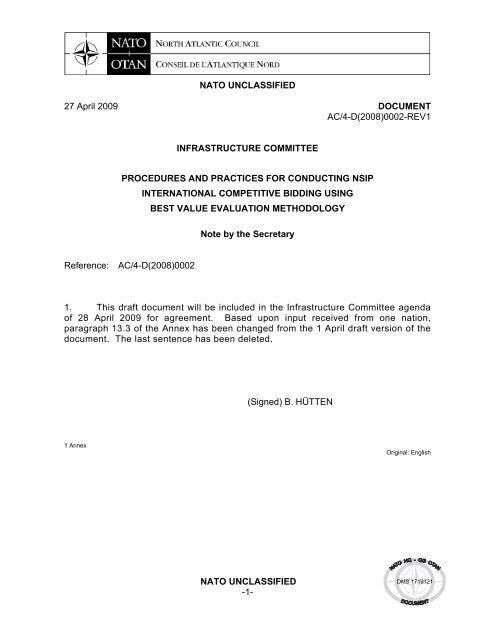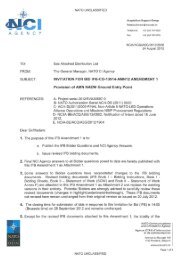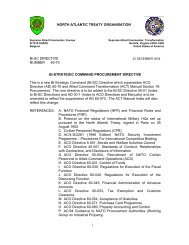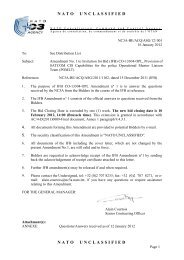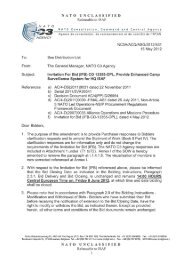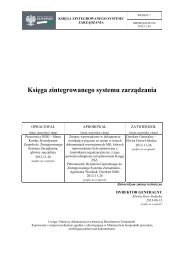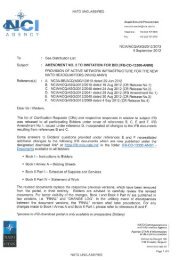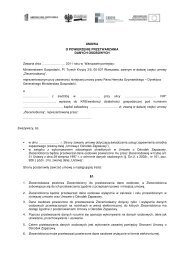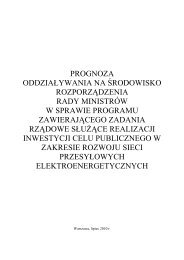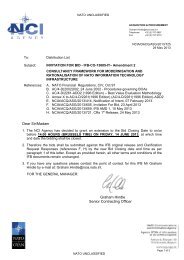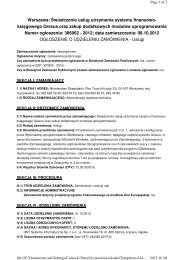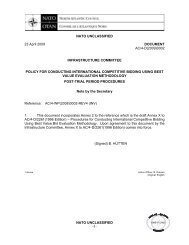NATO UNCLASSIFIED 27 April 2009 DOCUMENT AC/4-D(2008 ...
NATO UNCLASSIFIED 27 April 2009 DOCUMENT AC/4-D(2008 ...
NATO UNCLASSIFIED 27 April 2009 DOCUMENT AC/4-D(2008 ...
You also want an ePaper? Increase the reach of your titles
YUMPU automatically turns print PDFs into web optimized ePapers that Google loves.
<strong>NATO</strong> <strong>UNCLASSIFIED</strong><strong>27</strong> <strong>April</strong> <strong>2009</strong> <strong>DOCUMENT</strong><strong>AC</strong>/4-D(<strong>2008</strong>)0002-REV1INFRASTRUCTURE COMMITTEEPROCEDURES AND PR<strong>AC</strong>TICES FOR CONDUCTING NSIPINTERNATIONAL COMPETITIVE BIDDING USINGBEST VALUE EVALUATION METHODOLOGYNote by the SecretaryReference:<strong>AC</strong>/4-D(<strong>2008</strong>)00021. This draft document will be included in the Infrastructure Committee agendaof 28 <strong>April</strong> <strong>2009</strong> for agreement. Based upon input received from one nation,paragraph 13.3 of the Annex has been changed from the 1 <strong>April</strong> draft version of thedocument. The last sentence has been deleted.(Signed) B. HÜTTEN1 AnnexOriginal: English<strong>NATO</strong> <strong>UNCLASSIFIED</strong>-1-DMS 1719121
<strong>NATO</strong> <strong>UNCLASSIFIED</strong>PROCEDURES AND PR<strong>AC</strong>TICES FOR CONDUCTING NSIPINTERNATIONAL COMPETITIVE BIDDING USINGBEST VALUE EVALUATION METHODOLOGYANNEX 1<strong>AC</strong>/4-D(<strong>2008</strong>)0002-REV1INTRODUCTION1. The <strong>NATO</strong> Security Investment Programme (NSIP) procedures for InternationalCompetitive Bidding (ICB) are detailed in <strong>AC</strong>/4-D/2261 (1996 Edition). This document wasdesigned primarily for classical infrastructure projects, such as civil works. Later, the ICBwas also utilized for other NSIP projects. These procedures are based upon contractaward to the bid that complies, both administratively and technically, with the requirementsof the Invitation for Bid (IFB) and gives the lowest price. This is known as the lowestcompliant bid.2. Experience has shown that the lowest compliant bid does not always represent themost cost-effective solution bid for <strong>NATO</strong>. Especially, the efficient investment inConsultation, Command, Control, Communications, Intelligence, Reconnaissance andSurveillance (C4IRS) projects, of high technical quality in a rapidly changing Informationand Communications Technology world, cannot always be achieved using the ICB, lowestcompliant bid procedure.3. An attempt to overcome the shortcomings of the basic procedure has been madeby the introduction of a variation - a Best Value (BV) procedure. BV procurement methodsare well known and widely used in national procurement actions. The BV procedure takesinto consideration several factors relating to the overall value and quality of the offer - suchas bidder’s recognized international certifications, supportability, management approach,quality assurance regime, delivery schedule, and technical merit which can be adequatelytaken into consideration during the bid evaluation. Introduction of BV procedures into NSIPprocurements would yield a new, effective and comprehensive procedure. The BVprocedure is primarily a risk mitigation measure in the implementation of complex projects.4. This document describes the BV procedure, aimed mainly at the procurement ofcomplex C4IRS systems and services, where the best value, i.e. the most economicallybeneficial offer, can be determined in an easy to understand and consistent way.AIM5. The aim of this document is to provide guidance to the host nation regarding BestValue competitions to be conducted in line with <strong>AC</strong>/4-D/2261 (1996 Edition), Annex X.<strong>NATO</strong> <strong>UNCLASSIFIED</strong>1-1
<strong>NATO</strong> <strong>UNCLASSIFIED</strong>ANNEX 1<strong>AC</strong>/4-D(<strong>2008</strong>)0002-REV110. Agreement to use the Best Value procedure. The intention of a Host Nation(HN) to apply the BV procedure for the implementation of a project should be indicated atthe earliest possible moment, i.e. when the HN submits a request for Advance PlanningFunds (APF), and not later than in the Type B Cost Estimate (TBCE) and request forauthorization to commit funds, which should include the pertinent justification. Use of theBV procedure shall be subject to agreement by the Infrastructure Committee (IC); ICB(<strong>AC</strong>/4-D/2261(1996 Edition)), lowest compliant bid, remains the default method unlessanother is agreed.11. Definitions11.1 Top-level criteria are the highest level summary categories that will be used toevaluate bids. In line with <strong>AC</strong>/4-D/2261-ADD1(1996 Edition), they have in the pastincluded price, engineering, management, and supportability (eg. Land C2 InformationServices) but limiting to price (P) and technical (T) is now preferred.11.2 A technical criterion is defined as an element against which the bidders’ technicalproposal will be evaluated and scored and the associated weighting factors.12. The HN shall include in the TBCE at least the following information:12.1 a detailed risk analysis identifying those areas of risk on which the riskcharacterization of the project is based;12.2 the two top-level criteria – price and technical;12.3 the second-level technical sub-criteria 1 and the associated weighting factors 2 , whichshould logically map the identified risks; with a general description of what is to beevaluated under each second-level technical sub-criteria; the recommended technical subcriteriawill usually cover project management, bidder’s recognized internationalcertifications, technical approach/proposal, supportability, risk mitigation plan, life-cycleconsiderations, intellectual property rights, availability of proven products and services,etc. They shall be subject to agreement by the IC;12.4 Technical criteria shall normally make up 50 percent of the overall weighting withprice constituting the remaining 50 percent. The host nation may propose alternateweighting arrangements. The alternative weighting arrangements shall be limited totechnical criteria weights of in between 40 and 60 percent of the overall weighting.12.5 the price not to be exceeded in the bids, which will be 125% of the unadjustedamount authorised as financial scope unless agreed otherwise by the IC; the host nationmay request a deviation from this requirement before issuing the cahier des charges 3 ; and1 Technical sub-criteria (T1, T2, …) are the different elements that constitute the Technical Criterion.2Weighting factors (a%, b%, …, z%) indicate the relative importance of the top-level criteria and thesecond-level technical sub-criteria.3 The request should be supported by data from a market survey, bidders’ conference or other source.<strong>NATO</strong> <strong>UNCLASSIFIED</strong>1-3
<strong>NATO</strong> <strong>UNCLASSIFIED</strong>ANNEX 1<strong>AC</strong>/4-D(<strong>2008</strong>)0002-REV112.6 whether the HN will evaluate the bid price on the basis of the investment cost or onthe basis of the life-cycle (investment and operation and maintenance) cost; where lifecycle costs are proposed as part of the bid evaluation, the host nation shall provide detailsregarding the services bidders must provide, the duration of the life cycle portion of thecontract, and other details deemed relevant; where life cycle costs are included, the priceto be evaluated shall be determined by the Present Value of the investment payments andthe operation and maintenance (including outsourced manpower that might be required)payments over the estimated life cycle of the system.13. Authorisation by the IC13.1 The request to use the BV procedure must be addressed in the screening reportby the International Staff 4 , with special reference to the advantages and disadvantagesand the mapping between identified risks and the recommended technical criteria and theirweights.13.2 In addition to those items specified in <strong>AC</strong>/4-D/2261-ADD1(1996 Edition), theauthorization granted by the IC shall include the “not-to-exceed” cost that will be includedin the “cahier des charges”, and the basis on which the price criterion will be evaluated(investment or life-cycle cost).13.3 If the host nation’s request to an alternate technical/price breakdown is not agreed,the overall weighting reverts to the default 50/50 ratio.13.4 The inclusion of life cycle costs as part of the bid evaluation process shall besubject to agreement by the IC.14. Other Considerations. In order to avoid specifying requirements for a level ofperformance that is impossible to meet with the existing and available technology or toavoid unrealistic cost estimates, the HN shall consider the use of the Optional PreliminaryBidding Procedure (Annex II of <strong>AC</strong>/4-D/2261(1996 Edition), i.e. Request For Bidder Views(RFBV), and/or market surveys, when proposing to use BV procedures and document theiractions/recommendations in the TBCE.4Also for reports on pre-financing statements or when the host nation requests agreement to theprocurement strategy prior to main scope authorisation.<strong>NATO</strong> <strong>UNCLASSIFIED</strong>1-4
<strong>NATO</strong> <strong>UNCLASSIFIED</strong>ANNEX 1<strong>AC</strong>/4-D(<strong>2008</strong>)0002-REV115. Best Value Requirements in the “Cahier des Charges”. The “cahier descharges” shall include the top-level criteria and the second-level technical sub-criteriatogether with the associated weighting factors, as authorized by the IC, and all third-leveltechnical sub-criteria 5 that will be subject to evaluation in descending order of importance.Additionally, the “not-to-exceed” cost, and both price realism and statistical tie provisionsmust be included along with those administrative and contractual criteria which must bemet in order to consider the bid compliant.CONDUCT OF BEST VALUE BID EVALUATIONS16. The HN shall establish a Host Nation Source Selection Body (HNSSB) at therelease of the IFB at the latest. The HNSSB will consist of, at least, a Source SelectionAuthority (SSA), a Contract Award Board (CAB), a Project Evaluation Board (PEB) andmore than one Evaluation Team.17. Major issues identified by the HN during the bidding process that would affect thescope or authorised amount, for example, unrealistic performance or cost estimates, shallbe referred back to the Infrastructure Committee.18. The bid evaluations shall follow a formal process approved by the SSA before theevaluation takes place (bid opening). All activities performed during the bid evaluationshall be documented and auditable.19. The steps involved in conducting a bid evaluation under the BV procedure shallinclude, as a minimum:Establishing the Evaluation Criteria.20. Third-level technical sub-criteria.20.1 The weighting factors for the third level (and any possible lower level) technical subcriteriashall not be included in the IFB but shall be predetermined by the HNSSO beforethe bids are evaluated. Only the Chairman of the CAB and a nominated expert will have acomplete knowledge of all weighting factors.20.2 They shall not be made known to bidders or the Evaluation Team members.Evaluation Methodology21. The detailed method in which the Host Nation evaluators shall conduct theirevaluation shall not be made available to bidders. Once approved by the SSA, the methodfor evaluating bids shall not be changed. The SSA shall ensure that the evaluation is fullydocumented, i.e. procedures are formally approved, officials are properly appointed,scores are recorded, etc, and carried out in a manner which is totally consistent with whathas been approved and with what has been described to bidders in the IFB.5 Third-level technical sub-criteria are the different elements in which each second-level technical criterioncan be broken down as decided by the HN.<strong>NATO</strong> <strong>UNCLASSIFIED</strong>1-5
<strong>NATO</strong> <strong>UNCLASSIFIED</strong>ANNEX 1<strong>AC</strong>/4-D(<strong>2008</strong>)0002-REV126. Price Realism26.1 In the event that the successful bidder has submitted a price quotation that is lessthan two-thirds of the average of remaining compliant bids, the host nation must ensurethat the successful bidder has not artificially reduced the offered price to assure contractaward. As such, the host nation will request the firm to provide clarification of the bid andwill inform the national delegation of the firm. In this regard, the bidder shall provide anexplanation to both the host nation and their national delegation on the basis of one of thefollowing reasons:- an error was made in the preparation of the price quotation. The bidder mustdocument the nature of the error and show background documentation regardingthe preparation of the price quotation that convincingly demonstrates that an errorwas made by the bidder. In such a case the Bidder may request to remain in thecompetition and accept the contract at the bid price, or to withdraw from thecompetition.- the bidder has a competitive advantage due to prior experience or internalbusiness/technological processes that demonstrably reduce costs to the bidderresulting in an offered price that is realistic. The bidder’s explanation must supportthe technical proposal offered and convincingly and objectively describe thecompetitive advantage and the savings achieved by this advantage over thestandard market costs, practices and technology.- the bidder understands that the submitted price quotation is unrealistically low incomparison with the level of effort required and, for business reasons, the bidder iswilling to absorb a loss. In this case, the bidder is required to estimate thepotential loss and show that the financial resources of the bidder are adequate towithstand such a reduction in revenue.26.2 If a bidder fails to submit a comprehensive and convincing explanation for one ofthe bases above, the host nation shall declare the bid non-compliant and the bidder 6 willbe so notified in accordance with the procedures set forth in paragraph 13(iii)(b) of <strong>AC</strong>/4-D/2261(1996 Edition). Non-compliance for reasons of bid realism is a basis for lodging acomplaint under the dispute procedure.26.3 If the host nation accepts the bidder’s explanation of a mistake and allows theBidder to accept the contract at the bid price or the explanation regarding competitiveadvantage is convincing, the bidder shall agree that the supporting pricing data submittedwith his bid will be the basis for determining fair and reasonable pricing for all subsequentnegotiations for modifications or additions to the contract and that no revisions of proposedprices will be made.6 In accordance with <strong>AC</strong>/4-D/2261(1996 Edition), also notified are the diplomatic representative of thecountry of origin of the firm concerned in the capital of the host nation (or in the case of a <strong>NATO</strong> Agency orStrategic Command, in the capital of the country in which the Agency or SC is located), <strong>NATO</strong> delegationof the country of origin, and the International Staff.<strong>NATO</strong> <strong>UNCLASSIFIED</strong>1-7
<strong>NATO</strong> <strong>UNCLASSIFIED</strong>ANNEX 1<strong>AC</strong>/4-D(<strong>2008</strong>)0002-REV1<strong>27</strong>. Phase 3. Best Value Final Score and Selection of the Successful Bid<strong>27</strong>.1 Upon approval of the price evaluation report, the CAB will open the technicalweighting scheme and apply the technical weight to the raw technical score to produce theweighted technical score.<strong>27</strong>.2 The weighted Technical Score will be determined according to the followingformula:where:TS = a%*TS1 + b%*TS2 + c%*TS3 +…TS1, TS2, TS3, …≤ 100 are the technical score of each of the authorisedsecond-level or published third-level technical sub-criteria; anda%, b%, c%, …are the related weighting factors for each of thesecond-level or third-level technical sub-criteria adding to 100.<strong>27</strong>.3 The Best Value Final Score (FS) will be the sum of weighted TS plus PS. Thecompliant bid with the highest score shall be the successful bid.where:FS = PS*z% + TS*(1-z%) ≤ 100z% is the authorised weighting factor for the Price Criterion.<strong>27</strong>.4 The bid having the highest Best Value final score will be selected as thesuccessful bid unless there is a statistical tie.28. Statistical Tie28.1 A statistical tie is deemed to exist when the final scores of the highest scoring bidsare within one point of each other. The host nation will then resolve the statistical tie usingthe appropriate tie-break mechanism.28.2 The tie-break mechanisms are as follows:- when the agreed weighting for the price criterion exceeds the weighting for thetechnical criterion, the bid having the lowest bid price will be selected as thesuccessful bid;- when the agreed weighting for the price criterion is less than or equal to theweighting for the technical criterion, the bid with the best cost/technical ratio –defined as the lowest cost per technical score, i.e. bid price divided by TS – willbe selected as the successful bid28.3 The tie-break mechanism shall be included in the “cahier des charges”.<strong>NATO</strong> <strong>UNCLASSIFIED</strong>1-8
<strong>NATO</strong> <strong>UNCLASSIFIED</strong>ANNEX 1<strong>AC</strong>/4-D(<strong>2008</strong>)0002-REV129. Notification of the Results of the Best Value Competition. The procedures in<strong>AC</strong>/4-D/2261(1996 Edition), Annex X are to be followed.30. Reporting. The normal reporting procedure as laid down in <strong>AC</strong>/4-D/2261(1996Edition) applies.---000---<strong>NATO</strong> <strong>UNCLASSIFIED</strong>1-9


